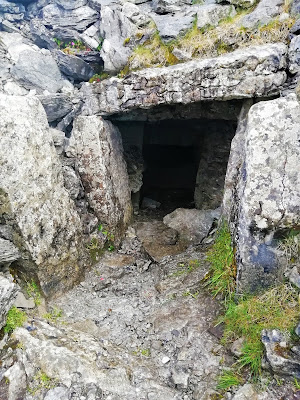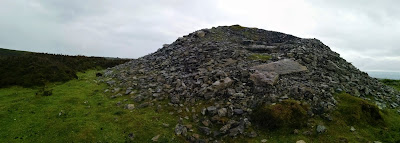There are few words which can appropriately describe Carrowkeel in Sligo.
Brú na Bóinne, Loughcrew, Seefin... there was nothing I had seen before which prepared me for what has been standing for much longer, here on the Bricklieve Hills in Sligo.
Possibly up to 6000 years old the Passage Tombs at Carrowkeel predate Loughcrew and Newgrange by perhaps 5 Centuries.
Staggeringly numerous there are 14 of them located here at Carrowkeel in close proximity to each other with about 20 or more in total spread out over a larger area.
Staggeringly numerous there are 14 of them located here at Carrowkeel in close proximity to each other with about 20 or more in total spread out over a larger area.
A recent trip to Tulsk in Roscommon saw me deciding to extend the journey and head for Carrowkeel in Sligo. I knew that it was the site of Neolithic Passage Tombs but I didn't know much more than that.
Traveling along the N4 Carrowkeel is easily located by turning off the main road at Castlebaldwin Village and following the well placed signage. After a few Kilometres along the Boreens you meet a gate. Open it and go through, closing it behind as you go and continue for another Kilometre. You're now at Carrowkeel and face a walk of roughly 2 Kilometres along a rutted hillside track.
The small Valley here feels remote and isolated and a world away from the busy site at Brú na Bóinne and Newgrange in Meath.
A word of warning first, there's no shuttle bus, no paved pathways, and no toilets nor the trappings of modernity at Carrowkeel.....Perfect.
As I approached Carrowkeel low cloud drew in and visibility was limited as I began to stroll up the grassy track occasionally passing disinterested Sheep and Lambs, a hardier horned breed of Sheep that we don't see in the midlands or east although they are just as skittish as Leinster Sheep.
In between the mist falling and lifting I spotted a Cairn to the left of the track and made my way over to it across the wet Heather. Good boots are a must here, especially in rain or mist. This Cairn had collapsed but the entrance still stood in a semi intact condition and was worth the short detour. With the mist around me I still couldn't see the main ridge of Cairns and Tombs so I just made my way back to the track and then continued upwards.
Throughout my wanderings at Carrowkeel the mist constantly lifted and fell again and again. When I reached the first Passage Tomb on the main spur I was both delighted and awestruck at the same time. Perhaps I'm easily pleased or a bit simple.... either way I find it humbling to be in the presence of buildings constructed so long ago by a people who had neither computers nor modern machinery.
The Carrowkeel Neolithic Passage Tomb Complex contains all 14 Cairns on several spurs/ridges which are extremely close together. I went from one Passage Tomb to the next over and over again, absolutely awestruck that so many were located so closely together. Every time the mist lifted I'd see another Cairn nearby.
A lot of the Passage Tombs are intact and if it takes your fancy (as it did mine) you can crawl into them. I brought a torch with me and from inside the construction of the various Tombs was clearly illuminated for me to see.
A lot of the Passage Tombs are intact and if it takes your fancy (as it did mine) you can crawl into them. I brought a torch with me and from inside the construction of the various Tombs was clearly illuminated for me to see.
The corbelled stone roofs, multi-chambered passages, lintels and capstones, were a timeless reflection of the numerous skills and abilities of our Stone Age forebearers.
Each Cairn has a letter as its official identifier but I had no idea which was which as I had come to Carrowkeel "on spec" forearmed with little information. I have to admit that wandering around clueless suited perfectly because these Tombs in a way then became my own personal "discovery."
Each Cairn has a letter as its official identifier but I had no idea which was which as I had come to Carrowkeel "on spec" forearmed with little information. I have to admit that wandering around clueless suited perfectly because these Tombs in a way then became my own personal "discovery."
At one point after leaving the main spur and weaving down through some crags to climb another spur I came across more Passage Tombs.
One Tomb in particular at Carrowkeel had a strange arrangement of large stone slabs in a "squarish" shape outside it.
I have subsequently discovered that some people refer to it as a Court Tomb while still others say it is not a Court Tomb at all. Take your pick from either explanation or imagine what it may be for yourself. Your guess is as good as anybody's.
One Tomb in particular at Carrowkeel had a strange arrangement of large stone slabs in a "squarish" shape outside it.
I have subsequently discovered that some people refer to it as a Court Tomb while still others say it is not a Court Tomb at all. Take your pick from either explanation or imagine what it may be for yourself. Your guess is as good as anybody's.
There is also a large Cist (Kist) type Tomb at Carrowkeel and I think I probably passed within metres of it but because of the mist I never saw a thing.
Another Passage Tomb at Carrowkeel has a "Light Box" structure on top which surprised
me as I had no knowledge that these existed outside Brú na Bóinne. I believe it illuminates the chamber on the Summer Solstice.
In 1911 R.A.S. Macalister and a team excavated many of the Tombs in a 15 day period. They mistakenly believed the structure to be Bronze Age and in their rush it is believed they used Sledgehammers, Shovels, and Explosives to gain entrance to many of the passages and chambers.
The bodged excavations caused several of them to collapse. Luckily for us they didn't manage to destroy them all.
The bodged excavations caused several of them to collapse. Luckily for us they didn't manage to destroy them all.
It was previously believed for a long time that Neolithic Rock Art was the preserve of the eastern sites such as Loughcrew, Brú na Bóinne, and Tara among others.
A paper by Robert Hensey and Guillaume Robin "More than meets the Eye : New recordings of Megalithic Art in North West Ireland" describes the use of VeDPOL (Vector Drawing from Digital Photographs taken with Oblique Lighting) in confirming Rock Art at many sites in this area including Carrowkeel. The actual dating of the Art itself is problematic, i.e. was it Neolithic or later Bronze Age.
A paper by Robert Hensey and Guillaume Robin "More than meets the Eye : New recordings of Megalithic Art in North West Ireland" describes the use of VeDPOL (Vector Drawing from Digital Photographs taken with Oblique Lighting) in confirming Rock Art at many sites in this area including Carrowkeel. The actual dating of the Art itself is problematic, i.e. was it Neolithic or later Bronze Age.
To illustrate the point, Newgrange although a Neolithic Megastructure was used by both Bronze and Iron Age peoples and Roman Coins have also been found there.
Many of these types of structure were used throughout antiquity by subsequent peoples who incorporated them into their own belief systems.
Many of these types of structure were used throughout antiquity by subsequent peoples who incorporated them into their own belief systems.
After about 2 hours or so I had visited 7 Passage Tombs and despite seeing another 2 Cairns on some further ridges I knew that it was unfortunately, all too soon, time to go.
When these Tombs were excavated in 1911 some of the objects found included cremated and non cremated (inhumation) remains, stone and bone tools, beads and pottery. The pottery found here gave its name to "Carrowkeel Ware" a simple and crude style of pottery.
In Sligo there is a wealth of Neolithic sites including Carrowmore, Heapstown, Kesh Corran (nearby) and Queen Maeve's Grave on Knocknarea among a host of others. The best way to see as much of it as possible would be to spend several days in the area.
Failing that you can visit Carrowkeel and see 6 or 7 Neolithic Passage Tombs in a few hours.
I doubt there's many places in the World where you could get to do that !
Failing that you can visit Carrowkeel and see 6 or 7 Neolithic Passage Tombs in a few hours.
I doubt there's many places in the World where you could get to do that !
The Bricklieve Hills overlook Lough Arrow, a very picturesque location. Mullaghfarna just behind Carrowkeel is the site of a large Neolithic settlement (perhaps the Carrowkeel builders) with the remains of over 150 hut and enclosure structures located there.
In 2001 a box of bones labelled "Carrowkeel" was discovered at the University of Cambridge. These were from Macalister's original excavations and were presumed lost. On close examination some showed signs of dismemberment which may have been a type of ritual Funerary Rite.
If you visit any of these sites it goes without saying that you shouldn't climb the Cairns. They've withstood 6000 years of Irish weather and Macalister's attentions. The least we can do is enjoy them without causing any further damage.
My Photograph's don't do the area justice. I took them whenever I got the chance as the mist cleared. On a bright sunny day the views must be stunning.
My Photograph's don't do the area justice. I took them whenever I got the chance as the mist cleared. On a bright sunny day the views must be stunning.
The Carrowkeel Complex was probably constructed over a thousand years before the Pyramid of Djoser and certainly that and more before Khufu had the great Pyramid of Giza (Cheops) constructed.
Video:Inside a Neolithic Passage Tomb
Video:Inside a Neolithic Passage Tomb























